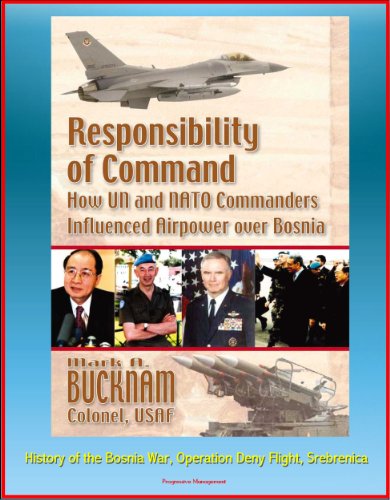Showing Responsibility of Command : How UN and NATO Commanders Influenced Airpower over Bosnia by Mark A. Bucknam
No recommendations yet View on Amazon (paid link)
This book examines the role that theater-level commanders in the UN and NATO played in influencing the use of airpower over Bosnia between the spring of 1993 and the end of 1995. It also uncovers factors explaining why top UN and NATO commanders in the region acted as they did. The central thesis of this study is that the commanders' needs to balance the various responsibilities inherent in command powerfully affected their actions when they tried to influence the use of airpower. Stress on these commanders was greatest when they felt forced to make trade-offs that put their forces at risk without a corresponding payoff in terms of mission accomplishment. In attempting to strike the proper balance between mission accomplishment, acceptable risk, and obedience to civilian political control, commanders drew on their own expertise and that of their staffs. Not surprisingly then the traditional division between soldiers and airmen over the utility of airpower manifested itself in a split dividing UN army generals from senior NATO airmen. That split also helps to explain the commanders' actions.
Because this case is presented in a chronological fashion, it offers a coherent account of Operation Deny Flight—the NATO air operations over Bosnia from April 1993 until December 1995. From start to finish, theater-level commanders acted as more than mere executors of policy. They helped to define their own missions, strove to control the use of airpower, and generally struggled to maintain operational autonomy so they could fulfill their responsibilities for mission accomplishment at acceptable levels of risk to their forces.
CONTENTS * PREFACE * ACKNOWLEDGMENTS * CHAPTER 1 * INTRODUCTION * Existing Literature * Method * Structure * Notes * CHAPTER 2 * MILITARY INFLUENCE ON THE USE OF AIRPOWER * Influence and Autonomy: The US Military and the Use of Force * Deciding to Use Force: Military Reluctance and Influence * How To Use Force: Options, Influence, and Overwhelming Force * Theoretical Bases of Demands for Operational Autonomy: Expertise and Responsibility * Political Constraints on Airpower: Targeting and Rules of Engagement * Targeting as Air Strategy: What to Attack, What Not to Attack * Bombing Pauses: When to Bomb or Not Bomb * Rules of Engagement: Circumstances for Force * Soldiers and Airmen: Efficacy and Control of Airpower * Summary * Notes * CHAPTER 3 * BACKGROUND ON THE USE OF AIRPOWER IN BOSNIA: 1992-APRIL 1993 * Airpower and Policy Making in the United States, France, and the United Kingdom * Early USAFE Planning * NATO Involvement in Bosnia * Enforcing the No-Fly Zone * "Safe Areas" and "Lift and Strike" * Conclusion * Notes * CHAPTER 4 * NATO AIR SUPPORT AND AIR STRIKES: MAY-DECEMBER 1993 * UNSCR 836: "Safe Areas" and Airpower—Expanding the UNPROFOR Mandate and the Role of NATO: May-July 1993 * UNSCR 844: Implementing an Ambiguous Policy * New Leadership for UNPROFOR * NATO Air-to-Ground Missions: June-August 1993 * Airpower and Coercion at Mount Igman: August 1993 * Command without Control: September-December 1993 * UNPROFOR Commanders Strive to Control NATO Close Air Support * Absent Political Guidance * Responsibility, Risks, and Accountability * Conclusion * Notes * CHAPTER 5 * AIRPOWER THREATS, USES, AND DISAPPOINTMENTS: JANUARY-JUNE 1994 * Commanders and Command Relationships * General Rose, Peacekeeping, and Airpower * Command Relationships, Air Strikes, and Close Air Support * The Sarajevo Ultimatum: February 1994 * Military Influence * Airpower, Control, and Autonomy * No-Fly Zone Enforcement and First CAS Approval: February-March 1994 * NATO Downs Serb Aircraft in the No-Fly Zone * Close Air Support * Turning Point: Gorazde, April 1994 * North Atlantic Council Decisions and the Gorazde Ultimatum * UN and NATO Missions in Bosnia: A Matter of Interpretation and Political Guidance * Trust, Expertise, and Forces at Risk * much more.